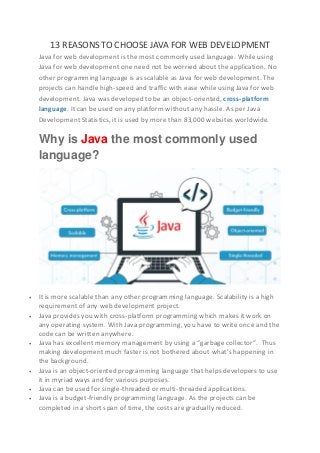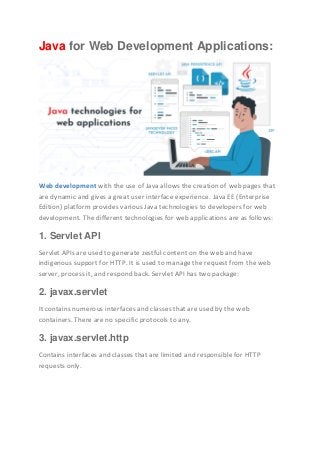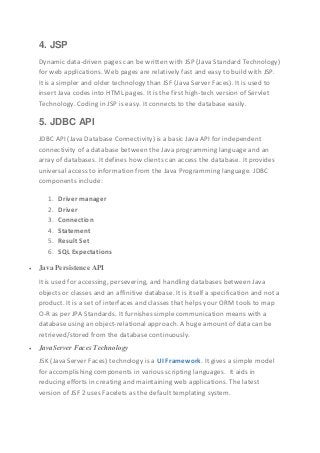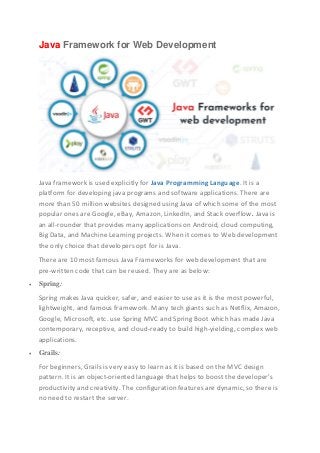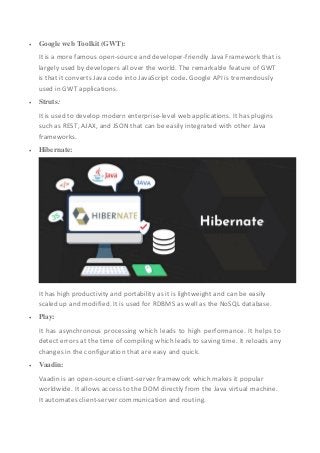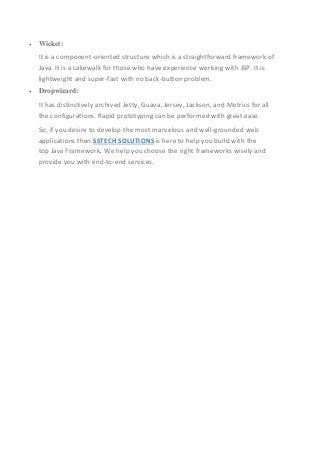13 REASONS TO CHOOSE JAVA FOR WEB DEVELOPMENT | SSTECH SYSTEM
- 1. 13 REASONS TO CHOOSE JAVA FOR WEB DEVELOPMENT Java for web development is the most commonly used language. While using Java for web development one need not be worried about the application. No other programming language is as scalable as Java for web development. The projects can handle high-speed and traffic with ease while using Java for web development. Java was developed to be an object-oriented, cross-platform language. It can be used on any platform without any hassle. As per Java Development Statistics, it is used by more than 83,000 websites worldwide. Why is Java the most commonly used language? ’éĘ It is more scalable than any other programming language. Scalability is a high requirement of any web development project. ’éĘ Java provides you with cross-platform programming which makes it work on any operating system. With Java programming, you have to write once and the code can be written anywhere. ’éĘ Java has excellent memory management by using a ŌĆ£garbage collectorŌĆØ. Thus making development much faster is not bothered about whatŌĆÖs happening in the background. ’éĘ Java is an object-oriented programming language that helps developers to use it in myriad ways and for various purposes. ’éĘ Java can be used for single-threaded or multi-threaded applications. ’éĘ Java is a budget-friendly programming language. As the projects can be completed in a short span of time, the costs are gradually reduced.
- 2. Java for Web Development Applications: Web development with the use of Java allows the creation of web pages that are dynamic and gives a great user interface experience. Java EE (Enterprise Edition) platform provides various Java technologies to developers for web development. The different technologies for web applications are as follows: 1. Servlet API Servlet APIs are used to generate zestful content on the web and have indigenous support for HTTP. It is used to manage the request from the web server, process it, and respond back. Servlet API has two package: 2. javax.servlet It contains numerous interfaces and classes that are used by the web containers. There are no specific protocols to any. 3. javax.servlet.http Contains interfaces and classes that are limited and responsible for HTTP requests only.
- 3. 4. JSP Dynamic data-driven pages can be written with JSP (Java Standard Technology) for web applications. Web pages are relatively fast and easy to build with JSP. It is a simpler and older technology than JSF (Java Server Faces). It is used to insert Java codes into HTML pages. It is the first high-tech version of Servlet Technology. Coding in JSP is easy. It connects to the database easily. 5. JDBC API JDBC API (Java Database Connectivity) is a basic Java API for independent connectivity of a database between the Java programming language and an array of databases. It defines how clients can access the database. It provides universal access to information from the Java Programming language. JDBC components include: 1. Driver manager 2. Driver 3. Connection 4. Statement 5. Result Set 6. SQL Expectations ’éĘ Java Persistence API It is used for accessing, persevering, and handling databases between Java objects or classes and an affinitive database. It is itself a specification and not a product. It is a set of interfaces and classes that helps your ORM tools to map O-R as per JPA Standards. It furnishes simple communication means with a database using an object-relational approach. A huge amount of data can be retrieved/stored from the database continuously. ’éĘ JavaServer Faces Technology JSK (Java Server Faces) technology is a UI Framework. It gives a simple model for accomplishing components in various scripting languages. It aids in reducing efforts in creating and maintaining web applications. The latest version of JSF 2 uses Facelets as the default templating system.
- 4. Java Framework for Web Development Java framework is used explicitly for Java Programming Language. It is a platform for developing java programs and software applications. There are more than 50 million websites designed using Java of which some of the most popular ones are Google, eBay, Amazon, LinkedIn, and Stack overflow. Java is an all-rounder that provides many applications on Android, cloud computing, Big Data, and Machine Learning projects. When it comes to Web development the only choice that developers opt for is Java. There are 10 most famous Java Frameworks for web development that are pre-written code that can be reused. They are as below: ’éĘ Spring: Spring makes Java quicker, safer, and easier to use as it is the most powerful, lightweight, and famous framework. Many tech giants such as Netflix, Amazon, Google, Microsoft, etc. use Spring MVC and Spring Boot which has made Java contemporary, receptive, and cloud-ready to build high-yielding, complex web applications. ’éĘ Grails: For beginners, Grails is very easy to learn as it is based on the MVC design pattern. It is an object-oriented language that helps to boost the developerŌĆÖs productivity and creativity. The configuration features are dynamic, so there is no need to restart the server.
- 5. ’éĘ Google web Toolkit (GWT): It is a more famous open-source and developer-friendly Java Framework that is largely used by developers all over the world. The remarkable feature of GWT is that it converts Java code into JavaScript code. Google API is tremendously used in GWT applications. ’éĘ Struts: It is used to develop modern enterprise-level web applications. It has plugins such as REST, AJAX, and JSON that can be easily integrated with other Java frameworks. ’éĘ Hibernate: It has high productivity and portability as it is lightweight and can be easily scaled up and modified. It is used for RDBMS as well as the NoSQL database. ’éĘ Play: It has asynchronous processing which leads to high performance. It helps to detect errors at the time of compiling which leads to saving time. It reloads any changes in the configuration that are easy and quick. ’éĘ Vaadin: Vaadin is an open-source client-server framework which makes it popular worldwide. It allows access to the DOM directly from the Java virtual machine. It automates client-server communication and routing.
- 6. ’éĘ Wicket: It is a component-oriented structure which is a straightforward framework of Java. It is a cakewalk for those who have experience working with JSP. It is lightweight and super-fast with no back-button problem. ’éĘ Dropwizard: It has distinctively archived Jetty, Guava, Jersey, Jackson, and Metrics for all the configurations. Rapid prototyping can be performed with great ease. So, if you desire to develop the most marvelous and well-grounded web applications then SSTECH SOLUTIONS is here to help you build with the top Java Framework. We help you choose the right frameworks wisely and provide you with end-to-end services.

